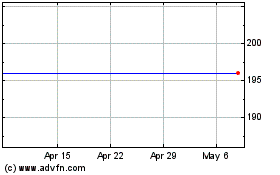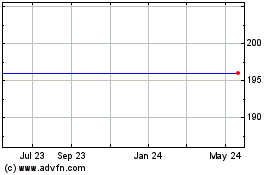By Deepa Seetharaman and Lauren Weber
Microsoft Corp.'s $26.2 billion acquisition of LinkedIn Corp.
gives new life to a social-networking pioneer that has built a huge
user base of mostly white-collar professionals but has struggled to
maintain its prominence in a competitive and fast-changing
sector.
Since co-founder and Executive Chairman Reid Hoffman initiated
LinkedIn 13 years ago by inviting 350 of his contacts to join, the
company has grown to claim 433 million members, including 105
million active monthly users.
It has become a central place online for professionals to
network and learn about job opportunities, making it enormously
valuable for executive recruiters and giving it a trove of data
that few other companies have. "LinkedIn's growing database of more
than 433 million 'resumes' is unlikely to ever be replicated by
another company," Cowen & Co analyst Gregg Moskowitz said in a
research note on Monday.
But users face ever greater demands on their online time from
social-media rivals such as Facebook Inc., which is also building
products for professionals such as Facebook at Work. Recruiters
still consider LinkedIn an essential tool, but some say its value
has diminished recently, with potential recruits using the platform
less often or replying infrequently to messages there.
A few years ago, "LinkedIn was a great way to reach talent that
we knew had live profiles, and that we could engage with," said
Richard Eib, chief executive at Xceli Global, which specializes in
hiring technology professionals with Salesforce.com expertise. Now,
with so many recruiters on LinkedIn, response rates are falling, he
said. "We don't see the return on investment we used to get."
About two-thirds of LinkedIn's $3 billion in revenue comes from
its talent-solutions division, which helps corporate recruiters
identify job candidates. The company also generates cash from
premium subscriptions and advertising.
Xceli spends $30,000 to $40,000 annually on LinkedIn, and Mr.
Eib says he gets high-quality leads there, but the firm now relies
more on Entelo Inc., one of a new generation of recruiting tools
that aggregates information from across public websites and social
media to automatically create profiles for potential hires. His No.
3 source is Twitter Inc.
Mr. Eib said the merger with Microsoft may "rekindle our
interest" in LinkedIn, particularly if recruiters are given new
ways to connect with potential candidates. Without clear advances,
Mr. Eib said he likely will scale back his spending on
LinkedIn.
"Before LinkedIn, the name of the game was finding people," said
Boris Epstein, co-founder of Bay Area-based Binc Search, which
recruits for technology firms.
"LinkedIn made it very easy to find people. Now the name of the
game is to engage people, and that is all about timing, interests,
and other things LinkedIn doesn't add a lot of value to."
LinkedIn's challenges earlier this year hammered its share
price, which fell by more than half after it delivered a
less-robust-than-expected earnings outlook.
The $26.2 billion in cash that Microsoft is paying, at a 50%
premium to Friday's closing price, gets LinkedIn's value back to
slightly above where it was before that plunge.
And according to LinkedIn Chief Executive Jeff Weiner, it places
the professional network among other giants of the tech
industry.
Mr. Hoffman, who owned 11% of LinkedIn's shares and held 53% of
its voting power as of last year, described the deal as "a
re-founding moment for LinkedIn."
He said: "I see incredible opportunity for our members and
customers and look forward to supporting this new and combined
business."LinkedIn said Mr. Hoffman, a former Apple Inc. and PayPal
executive who also is a partner at venture-capital firm Greylock
Partners, would continue to be involved informally in the
Microsoft-owned LinkedIn.
LinkedIn faces other difficulties. Its revenue growth has been
slowing, which is what spooked investors.
Earlier this year, the company projected revenue in 2016 would
grow roughly 22% -- down from 35% in 2015. It later boosted its
outlook, but revenue growth still looks poised to fall far short of
2015.
LinkedIn also has struggled to adapt to the mobile revolution, a
change that has greatly benefited Facebook -- though an overhaul of
its mobile app last year has shown signs of gaining traction.
LinkedIn is installed in fewer phones than heavily used apps
such as Facebook, Snapchat, Twitter Inc. and Instagram. But unlike
those four, users spent more time on the LinkedIn app in the first
quarter of 2016 compared with the year-ago period, according to
digital data firm SimilarWeb.
LinkedIn is the 28th most-visited website in the world and the
14th most popular in the U.S., says SimilarWeb.About one-third of
LinkedIn's traffic comes from the U.S. where users spend an average
of five minutes and 16 seconds a day in the app.
Several analysts downgraded the stock earlier this year. But
last week, RBC Capital Markets analyst Mark Mahaney upgraded
LinkedIn, citing his survey of 290 U.S. recruiters, which found 45%
of them would spend more on LinkedIn over the next 12 months and
48% would maintain their spending.
Write to Deepa Seetharaman at Deepa.Seetharaman@wsj.com and
Lauren Weber at lauren.weber@wsj.com
(END) Dow Jones Newswires
June 14, 2016 02:51 ET (06:51 GMT)
Copyright (c) 2016 Dow Jones & Company, Inc.
Linkedin Corp. Class A (NYSE:LNKD)
Historical Stock Chart
From Jun 2024 to Jul 2024

Linkedin Corp. Class A (NYSE:LNKD)
Historical Stock Chart
From Jul 2023 to Jul 2024
